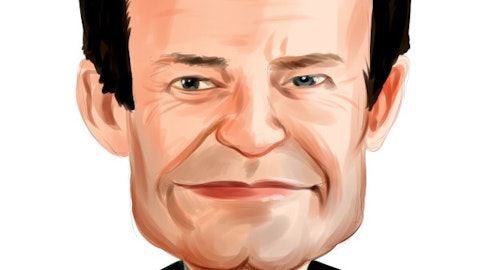We anticipate continued success in that and continued strong and healthy cash flow, but acknowledging that a lot of the oversize or supersize gains that we had on the reduction in build times was a little bit behind us at this point. So, sorry, your second question was?
Jeff Kaminski: 13%.
Jeff Mezger: Oh! The 13%, yeah, on the operating margin. Yeah. I think, like when you look at, I saw your report and know that that was the number you had in there. Look, it’s definitely within reach. I mean, we’re not going to go out and guide or lay out a plan for the company on a during a Q&A period of a quarterly conference call, but we’re within distance of that already and I’d hope to see improvement actually over and above that over time. That just requires about a point decrease in what we’re anticipating for this year’s SG&A, which I think comes with scale and size and leverage on some of our SG&A costs at this point. And as the market stabilizes and improves, particularly with declining rates that we do expect to see and reinforce today by some of the Fed’s comments, moving away from some of the incentives, which you know is not really part of our business model to get into that low 20s range.
I mean, we’re already there, but to improve on where we’re at today on the gross margin side. So I think it’s a reasonable assumption. I think it’s — I would like to think it’s on the very conservative side as far as a long-range target for the company and certainly attainable, so that’s basically my comments on that at a very high level.
Stephen Kim: Yeah. Appreciate that. Thanks very much, guys. That’s really encouraging. Second question relates to the big news regarding the NAR’s settlement that obviously I think has created a lot of turmoil. What I’m intrigued about is the potential for this confusion and the relatively quick time frame by which all these changes need to be made, whether that might result in a somewhat dysfunctional resale market that large builders such as yourselves could capitalize on with your Internet presences, which I know you’ve substantially bolstered over the last several years, and so my question is, can you give us a sense for what share of your leads today are generated through the Internet and do those Internet-driven leads carry a lower SG&A burden, when they ultimately come through in sales?
Jeff Mezger: Rob, do you have any detail on that, on the Internet leads and the profile?
Rob McGibney: Yeah. Steve, not so much as the percentage, but I would say, the majority of buyers that are finding us are finding us through those avenues and we’ve seen a big increase in our Internet leads just overall. It was up 34% year-over-year, so pretty big movement there. As far as the opportunity with the NAR and the settlement, I think it’s still a little cloudy to predict how that’s going to go. I think, if anything, it’s going to be a positive for us with potentially less that’s being paid in broker co-ops and things like that, but I think there’s a lot to be worked out there when that goes into effect this summer. One of the components of it is that the compensation can’t be advertised on the MLS, but then they likely have other ways to advertise that through Facebook or other methods or face-to-face.
So a lot of it remains to be seen. Certainly don’t see it as a downside to us, our results or our financials, potentially an upside, but I think it’s a little too early to tell.
Operator: And the next question comes from the line of Alan Ratner with Zelman & Associates. Please proceed with your question.
Alan Ratner: Hey, guys. Good afternoon. Nice quarter and I appreciate all the color so far. So my first question and I really appreciate all the statistics you gave on the credit side. I was admittedly a little surprised when one of your competitors last week kind of talked a little bit about some rising early-stage red — yellow flags or red flags in some of their customer credit metrics like credit card delinquencies and things like that. And I just want to make sure I’m thinking about your commentary in the same vein, because I think a lot of the statistics you gave are maybe on closings and kind of more representative of what might have been going on six months or so ago. So, can you just be clear that you are not seeing any signs of stress in kind of real-time in terms of the consumers that are coming through your model homes today?
Jeff Mezger: Yeah. I’ll take that one. I mean, really, when I was speaking about the debt-to-income ratios earlier, that actually was based on sales, not closings and we’ve seen…
Alan Ratner: Okay.
Jeff Mezger: … those ratios improve slightly over the last few quarters. Now, our leads are up. I talked a little bit about the Internet leads. So we’re seeing a lot more people. So the raw number of people that don’t qualify has increased. But as far as the percentage, I don’t really see that that’s changed much and we’re not seeing those pressures at this point.
Alan Ratner: Great. Okay. No. I appreciate that clarification.
Rob McGibney: I’d point to our can rate, too. And on the can rate, it’s now below normal for us and I think that’s the buyer’s ability to perform.
Alan Ratner: Yeah. That makes sense. Appreciate the clarification on that. So my second question is on kind of the land portfolio and nice pickup in land acquisition activity in the quarter. Your lot count, if I’m looking at this correctly, is down about 10% year-over-year, down almost 40% from two years ago and your year’s supply of land is kind of hovering in that four-ish-year metric, which is among the lower in the industry. And I’m just curious, is that — would you say that’s by design as an effort to kind of improve your capital efficiency or turnover, or is that land supply, I know you mentioned you’ve got all the land you need for 2025. But would you like to see that land pipeline a little bit higher than it is currently?





